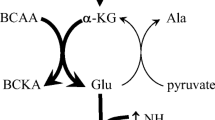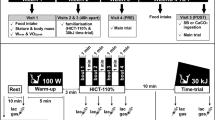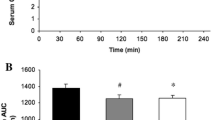Summary
Eleven laboratory-pretrained subjects (initial\(\dot V_{O_{2max} } \)=54 ml·kg−1·min−1) took part in a study to evaluate the effect of a short endurance training programme [8–12 sessions, 1 h per session, with an intensity varying from 60% to 90% maximal oxygen consumption\((\dot V_{O_{2max} } )\)] on the responses of blood ammonia (b[NH +4 ]) and lactate (b[la]) concentrations during progressive and constant exercise intensities. After training, during which\(\dot V_{O_{2max} } \) did not increase, significant decreases in b[NH +4 ], b[la] and muscle proton concentration were observed at the end of the 80%\(\dot V_{O_{2max} } \) constant exercise intensity, although b[NH +4 ] and b[la] during progressive exercise were unchanged. On the other hand, no correlations were found between muscle fibre composition and b[NH +4 ] in any of the exercise procedures. This study demonstrated that a constant exercise intensity was necessary to reveal the effect of training on muscle metabolic changes inducing the decrease in b[NH +4 ] and b[la]. At a relative power of exercise of 80%\(\dot V_{O_{2max} } \), there was no effect of muscle fibre composition on b[NH +4 ] accumulation.
Similar content being viewed by others
References
Babij P, Matthews SM, Rennie MJ (1983) Changes in blood ammonia, lactate and amino acids in relation to workload during bicycle ergometer exercise in man. Eur J Appl Physiol 50:405–411
Brooke MH, Kaiser KK (1970) Three “myosin adenisine triphosphatase” systems: the nature of their pH lability and sulfhydryl dependence. J Histochem Cytochem 18:670–672
Buono MJ, Clancy TR, Cook JR (1984) Blood lactate and ammonium ion accumulation during graded exercise in humans. J Appl Physiol 57:135–139
Costill DL, Sharp RL, Fink WJ, Katz A (1982) Determination of human muscle pH in needle-biopsy specimens. J Appl Physiol 53:1310–1313
Denis C, Dormois D, Castells J, Bonnefoy R, Padilla S, Geyssant A, Lacour JR (1988) Comparison of incremental and steady-state tests of endurance training. Eur J Appl Physiol 57:474–481
Dudley GA, Terjung RL (1985) Influence of aerobic metabolism on IMP accumulation in fast-twitch muscle. Am J Physiol (Cell Physiol 17):C37–C42
Dudley GA, Saron RS, Murray TF, Hagerman FC, Luginbuhl A (1983) Muscle fiber composition and blood ammonia levels after intense exercise in humans. J Appl Physiol 54:582–586
Gaudebout G, Blayo MC (1975) Assessment of Scholander micromethod for gas concentrations versus weighing method. J Appl Physiol 38:546–549
Geyssant A, Dormois D, Barthelemy JC, Lacour JR (1985) Lactate determination with the lactate analyser LA 640: a critical study. Scand J Clin Lab Invest 45:145–149
Graham TE, Pedersen PK, Saltin B (1987) Muscle and blood lactate responses to prolonged exercise with hyperoxia. J Appl Physiol 63:1457–1462
Henriksson J, Reitman JS (1977) Time course if changes in human skeletal muscle succinate dehydrogenase and cytochrome oxidase activities and maximal oxygen uptake with physical activity and inactivity. Acta Physiol Scand 99:91–97
Katz A, Sahlin K (1988) Regulation of lactic acid production during exercise. J Appl Physiol 65:509–518
Katz A, Sahlin K, Henriksson J (1986) Muscle ammonia metabolism during isometric contraction in humans. Am J Physiol [Cell Physiol 19]:C834–C840
Kun E, Kearny EB (1974) Ammonia. In: Bergmeyer HU (ed) Methods of enzymatic analysis, vol 4. Academic Press, New York, pp 1802–1806
Lo PY, Dudley GA (1987) Endurance training reduces the magnitude of exercise-induced hyperammonemia in humans. J Appl Physiol 62:1227–1230
Mutch BJC, Banister EW (1983) Ammonia metabolism in exercise and fatigue: a review. Med Sci Sports Exerc 15:41–50
Novikoff AB, Shin W, Drucker J (1961) Mitochondrial localization of oxidation enzymes: staining results with two tetrazolium salts. J Biophys Biochem Cytol 9:47–61
Rusko H, Luthanen P, Rahkila P, Viitasalo J, Rehunen S, Härkönen M (1986) Muscle metabolism, blood lactate and oxygen uptake in steady-state at aerobic and anaerobic thresholds. Eur J Appl Physiol 5:181–186
Sjödin B, Jacobs I, Svedenhag J (1982) Changes in onset of blood lactate accumulation (OBLA) and muscle enzymes after training at OBLA. Eur J Appl Physiol 49:45–57
Terjung RL, Dudley GA, Meyer RA, Hood DA, Gorski J (1986) Purine nucleotide cycle function in contracting muscle. In: Saltin B (ed) Biochemistry of Exercise VI. Human Kinetics, Champaign, Illinois, pp 131–147
Author information
Authors and Affiliations
Rights and permissions
About this article
Cite this article
Denis, C., Linossier, MT., Dormois, D. et al. Effects of endurance training on hyperammonaemia during a 45-min constant exercise intensity. Europ. J. Appl. Physiol. 59, 268–272 (1989). https://doi.org/10.1007/BF02388327
Accepted:
Issue Date:
DOI: https://doi.org/10.1007/BF02388327




